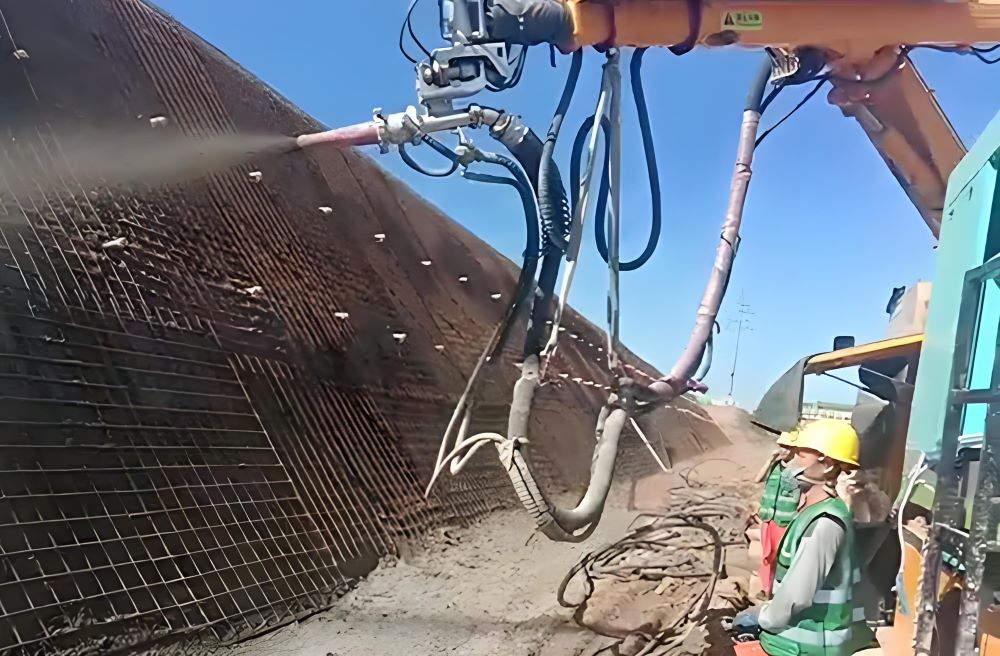Wet shotcrete sprayer offer significant advantages over traditional dry shotcrete trolleys (dry shotcrete equipment) in terms of construction quality, environmental friendliness, and cost-effectiveness. This is the core reason why wet shotcrete is gradually replacing dry shotcrete as the mainstream technology. Specific advantages are as follows:

1. More stable concrete quality and more reliable strength
Wet shotcrete sprayer use premixed wet concrete (pre-mixed according to precise proportions, containing cement, aggregate, water, and additives). Parameters such as the water-cement ratio and aggregate gradation are strictly controlled at the batching plant, resulting in highly homogeneous concrete and stable, controllable properties such as strength and density after hardening.
Dry shotcrete trolleys, on the other hand, utilize a "dry material (cement + aggregate) delivery + water addition at the nozzle." The water-cement ratio relies on manual adjustment at the nozzle, which can easily lead to areas of over-dryness or over-wetness due to uneven water addition. This can cause fluctuations in concrete strength (such as insufficient strength and cracking), resulting in poor quality stability.
2. Extremely low rebound rate, minimal material waste
Wet sprayed concrete is a plastic wet material. Adding an accelerator to the nozzle allows for rapid initial setting (from seconds to minutes). Once sprayed onto the surface, it exhibits strong adhesion, resulting in a rebound rate typically less than 15% (some advanced equipment can reduce this to less than 10%).
Dry spraying, due to the short mixing time between the dry material and water at the nozzle, results in poor adhesion and lacks premature setting. The rebound rate can reach as high as 30%-50%. This results in a significant amount of concrete being wasted due to rebound, increasing material costs and requiring additional cleanup, impacting construction progress.
3. Minimal dust pollution, making it more environmentally friendly and healthier.
Wet sprayed concrete is watered during the mixing stage. No dry aggregate is generated during transportation and spraying. Furthermore, the accelerator is mixed with the wet material in liquid form, further reducing dust generation. Dust concentrations in the working environment are typically less than 2 mg/m³ (well below national standards).
Dry spraying, however, generates large amounts of dust during the transportation and mixing of dry materials (cement, sand, etc.) through the nozzles. Dust concentrations often exceed 10 mg/m³, severely harming workers' respiratory health and failing to meet modern engineering environmental protection requirements (such as dust limits for tunnel construction).
4. Higher construction efficiency and adaptability to large-scale projects
Wet spraying trolleys are equipped with high-pressure pumping systems (such as hydraulic piston pumps) and multi-section hydraulic booms, enabling continuous, high-volume spraying (up to 10-30 m³ per hour). The booms offer a wide and flexible coverage range, making them suitable for large-scale projects such as tunnels and slopes.
Dry spraying relies on compressed air to push dry materials, resulting in low flow rates and the risk of pipe clogging, requiring frequent downtime for cleaning. Its efficiency is only one-third to one-half that of wet spraying, making it difficult to meet the demands of high-intensity construction.
5. Greater concrete durability and improved support effectiveness
Wet shotcrete, due to its precise water-cement ratio and high density (due to high-pressure spraying and extrusion), is significantly more impermeable and crack-resistant than dry shotcrete. This effectively reduces problems such as leakage and weathering, extending the life of the support structure.
Dry shotcrete, due to its low density and numerous internal pores, is susceptible to water penetration, leading to steel corrosion and structural strength degradation, resulting in poor long-term stability.
6. More convenient operation and less reliance on manual labor
The wet shotcrete trolley has an integrated automated control system, allowing for coordinated adjustment of parameters such as pumping speed, accelerator dosage, and air volume via a touchscreen interface, reducing manual intervention. Dry shotcrete, on the other hand, requires real-time manual adjustment of the nozzle water level, requiring significant operator experience and prone to quality issues due to human error.
With its core advantages of "premixed wet materials + precise control + low rebound + low pollution", the wet spraying trolley comprehensively surpasses the dry spraying trolley in terms of quality, efficiency, environmental protection and other dimensions. It is particularly suitable for the requirements of modern engineering for "high quality, high efficiency, low loss and green construction" and has become the preferred equipment for concrete support in tunnels, mines, municipal engineering and other projects.





